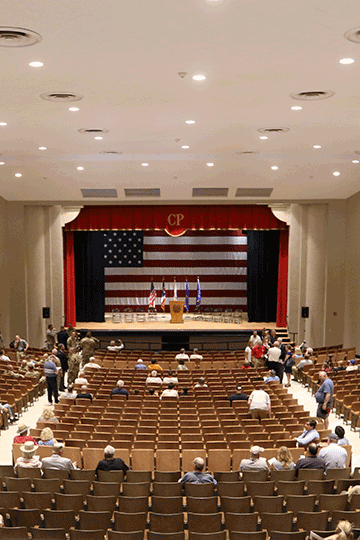
PORT CLINTON, Ohio (07/09/18) — The Ohio National Guard welcomed visitors July 9 at the Camp Perry Joint Training Center to celebrate the grand reopening of the historic Hough Auditorium.
The facility’s $1.6 million renovations to entranceways, seating, restrooms and lighting encompassed over 13,600 square feet, and is part of more than $3.5 million in improvements at Camp Perry.
“We are making an investment in Camp Perry Joint Training Center to preserve more than a century of military history and to improve facilities used year-round by the Ohio National Guard and the community,” said Maj. Gen Mark E. Bartman, Ohio adjutant general.
Originally built in 1938 for $70,000, which translates to a value today of more than $1.2 million, the theater has hosted such prominent figures as Bing Crosby and Bob Hope and generations of Ohio National Guard Soldiers throughout its history. In recent years there have been issues at the aging structure with flooding and standing water, floors caving in, broken seating and unusable restrooms.
The renovations pay homage to the historical value inherent in the building by maintaining some of the original seating, the large murals on the walls, and glass cases full of old photos and theater equipment.
The State Historic Preservation Office’s Joy Williams was instrumental in protecting these historical aspects and Bartman presented her with the Ohio Commendation Medal for her efforts.
“It was just a great project where we got to do a lot of rehabilitation work and save some of the historic features of the property and really bring it back to life, not only for Camp Perry but for the community as well,” Williams said.
Following the ribbon-cutting ceremony, the first event in the newly renovated auditorium was a medals ceremony for former Army Staff Sgt. and Vietnam veteran Steven Fultz of Port Clinton. Fifty years after his service as a helicopter door gunner and flight engineer, Fultz accepted the Bronze Star Medal for meritorious service in a combat zone, the Air Medal for meritorious achievement while participating in aerial flight and other ribbons earned during his Vietnam service.
The auditorium’s reopening was held in conjunction with the opening ceremonies for the Civilian Marksmanship Program National Matches. Maj. Gen. Clark Lemasters of the U.S. Army Tank-Automotive and Armaments Command had the honor of firing the ceremonial “first shot,” which begins the five-weeklong shooting competition held at Camp Perry for more than a century, for shooters of all ages and skill levels.
Camp Perry Joint Training Center is located on the shores of Lake Erie in Ottawa County and includes a National Guard training facility, public lodging and banquet facilities. It opened in 1907 as a state rifle range and camp. During World War I, it was used as a training center for officers and marksmanship instructors, and it was used during World War II as a reception center for the new recruits and to house German and Italian prisoners of war. |